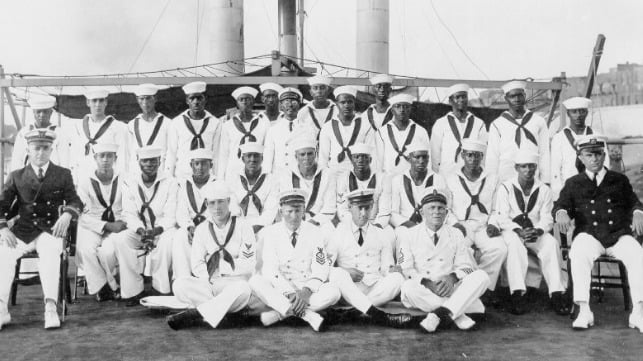100 Years Ago, One Coast Guard Cutter Defied Segregation

Throughout the history of the U.S. Coast Guard, the nation has tasked the service with new missions to respond to all sorts of maritime threats and crisis. Such was the case with the Great Flood of 1913, considered by many as the most devastating flood in U.S. history.
In the list of deadly American floods, the Great 1913 Flood ranks only second in number of lives lost. The 1889 Johnstown Flood distinguished itself as the deadliest with approximately 2,200 victims killed in the small city of Johnston, Pennsylvania. However, the 1913 Flood affected over a dozen states, killed between 600 and 900 civilians, caused hundreds of millions in damage and left homeless 250,000 Americans.

Photograph of a man and wife in Dayton, Ohio, stranded on top of their front porch during the Great Flood of 1913. Photo courtesy of Wright State University.
Because of this natural disaster, Congress voted to fund federal flood relief and rescue work on the Ohio and Mississippi Rivers. On Aug. 29, 1916, it passed a naval appropriations bill that included money for the construction of three “light-draft river steamboats” for the Coast Guard. Their mission was to “give relief, succor, and assistance to victims of floods” on the two major river systems. In addition to their specialized riverine duty, the cutters would support the usual Coast Guard missions of “rendering assistance to vessels in distress, saving life and property, protecting the revenue, enforcing the navigation and motor-boat laws, and prosecuting such other work as properly may come with the purview of the service.”
Of the three “river cutters” funded by Congress, only two were completed. These were the cutters Yocona and Kankakee, constructed in Dubuque, Iowa. The service commissioned them both on Oct. 19, 1919, and stationed the Kankakee on the Ohio River at Evansville, Indiana; and the Yocona on the Mississippi River at Vicksburg, Mississippi. Kankakee took up its station on March 20, 1920, and Yocona took up its station earlier that year, on Jan. 18. As the earliest river cutter to carry out its duties, Yocona became the first Coast Guard cutter of any kind to operate on the nation’s inland rivers.

Picture of a flotilla of Coast Guard 23-foot patrol boats rafted next to a Coast Guard river cutter. Photo courtesy of U.S. Coast Guard.
Designed as flood-response command ships, Yocona and Kankakee incorporated the latest riverine technology. These 182-foot steel-hulled riverboats were powered by stern paddlewheels designed for river navigation and they carried a complement of 35 officers and men. Drawing only 3 1/2 feet when fully loaded, Yocona’s flat hull was ideal for shallow waters. The cutters were also equipped with dual searchlights, powerful water pumps, advanced radio equipment and spacious cabins to house flood victims. In the event of a flood, they could serve as a command vessel supporting a flotilla of smallboats and river craft used to rescue and transport disaster victims.
In addition to Yocona’s specialized design, the cutter proved unique in the nation’s history of racial desegregation. Within a year of Yocona’s commissioning, it received an entirely black enlisted force while Kankakee’s crew was composed of only white officers and men. With the exception of officers and non-commissioned officers, Yocona’s enlisted crew was entirely African-American, including petty officers in every rating.
By recruiting an all-black enlisted force of petty officers, Yocona’s officers had set a precedent for desegregating the nation’s sea service vessels. While Yocona may be the first desegregated federal ship in American history, the service never publicly recognized the groundbreaking cutter as such. More than likely, the Coast Guard recruited the best-qualified watermen near Yocona’s homeport of Vicksburg. The fact that the Coast Guard operated a cutter with an integrated crew nearly 100 years ago is history making in itself. However, the fact that Yocona was homeported in a state that held the nation’s worst record of discrimination and violence toward blacks makes this achievement all the more remarkable.

Cutter Sea Cloud earned greater fame as the first officially desegregated federal ship with African-Americans serving not only as ordinary petty officers but also as officers and non-commissioned officers. Photo courtesy of U.S. Coast Guard.
Desegregation of U.S. Navy ships came over 20 years later. In the spring of 1944, the Navy desegregated its first ship using Yocona’s system of black enlisted men with white officers and non-commissioned officers (NCOs). On the other hand, the Coast Guard’s wartime desegregated cutters, such as the USS Sea Cloud, assigned African-American men to every level of command, including officers and NCOs. Moreover, the Coast Guard’s wartime desegregated cutters began operating a year earlier than the Navy’s first integrated warships, such as the Destroyer Escort USS Mason, which was made famous through books and movies.
The Coast Guard stationed cutter Yocona at Vicksburg through 1925 to provide flood assistance during the seasonal floods that historically plagued the Mississippi. Yocona proved a pioneering cutter in three ways. In a service known to adopt new kinds of ship hulls and propulsion, the river cutter was the Coast Guard’s first stern paddlewheeler. Yocona was also the first Coast Guard cutter stationed on the nation’s rivers. More importantly, Yocona proved the first federal vessel in peacetime manned by a racially integrated crew. Ironically, this desegregated cutter’s homeport was located in the Deep South 100 years ago. Yocona’s achievement remains an important chapter in American minority history and the story of the long blue line.
William Thiessen is the Coast Guard Atlantic Area historian. This article appears courtes of Coast Guard Compass, and it may be found in its original form here.
The opinions expressed herein are the author's and not necessarily those of The Maritime Executive.
